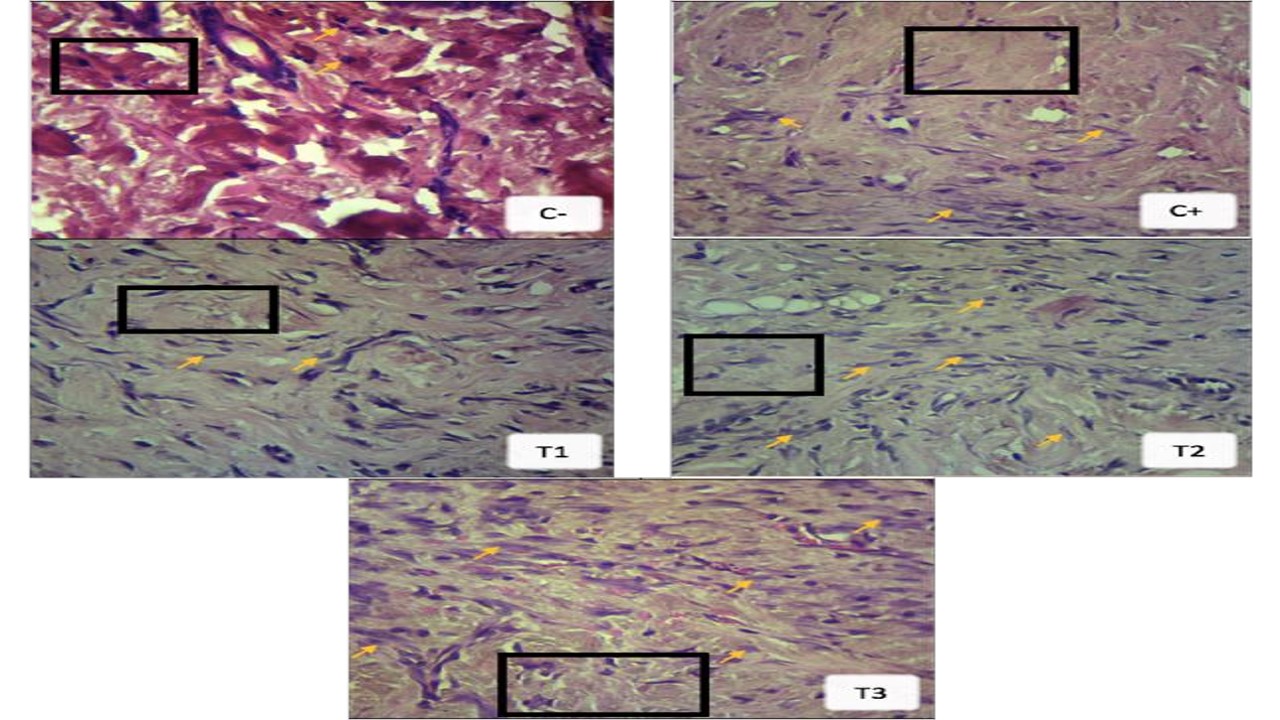The Efficacy of Madeira Vine Leaf Extract Combined with Turmeric Rhizome Extract Gel Topically on Second-Degree Burn Wound in Albino Rats

Downloads
Burns is now considered one of the most destructive forms of trauma affecting humans and animals. This study aimed to determine the effect of Madeira vine leaf extract combined with 2% Turmeric rhizome extract (MVLTR) gel administered topically on second-degree burn wound in albino rats based on the number of fibroblasts. A total of 25 male rats weighed 200–300 grams were divided into five groups i.e. (C-) was normal skin, (C+) was burn and treated using 1% silver sulfadiazine, (T1) was burn and treated using 1.25% MVLTR gel, (T2) was burn and treated using 2.5% MVLTR gel, and (T3) was burn and treated using 5% MVLTR gel. The burn wound was performed on the right gluteus of rats, and the therapy was applied twice a day topically, starting after the burn wounds were made. Skin samples were collected on day 15. The histopathological examination was performed by counting fibroblast cells and then analyzed using One-way ANOVA, continued with the Duncan test. Based on the results showed that the C- group was significantly different compared to C+, T1, T2, and T3 groups. C+ had a significant difference with the T1 and T3 groups, meanwhile not significantly different from the T2 group. T2 was not significantly different from the C+ and T3 groups. In conclusion, MVLTR gel at 5% concentration has the potential to be an effective treatment for second-degree burns, as indicated by the increased number of fibroblasts.
Al-Anshori, A. A., Putri, A. N., Ismi, A. N., Suhud, M. K., Plumeriastuti, H., & Maslachah, L. (2023). Efficacy of Transdermal Delivery Nano Ethosomal Gel from Ashitaba Leaves on In-vivo Burn Wound Healing in Albino Rats. Jurnal Medik Veteriner, 6(2), 145–154.
Anand, P., Kunnumakkara, A. B., Newman, R. A., & Aggarwal, B. B. (2007). Bioavailability of curcumin: problems and promises. Molecular Pharmaceutics, 4(6), 807–818.
Ashok, P. K., & Upadhyaya, K. (2012). Tannins are astringent. Journal of Pharmacognosy and Phytochemistry, 1(3), 45–50.
Astuti, S. M., Mimi, S. A. M., Retno, A. B. M., & Risch, A. (2011). Determination of saponin compound from Andera cordifolia (Ten.) Steenis plant (Binahong) to potential treatment for several diseases. Journal of Agricultural Science, 3(4), 224–232.
Bewick, V., Cheek, L., & Ball, J. (2004). Statistics review 9: one-way analysis of variance. Critical Care, 8(2), 130–136.
Cahya, R. W., Yudaniayanti, I. S., Wibawati, P. A., Yunita, M. N., Triakoso, N., & Saputro, A. L. (2020). The Effect of Sukun Leaf (Artocarpus altilis) Extract on Collagen Density of Excision Wound Healing in Albino Rats (Rattus norvegicus). Jurnal Medik Veteriner, 3(1), 25–30.
Church, D., Elsayed, S., Reid, O., Winston, B., & Lindsay, R. (2006). Burn wound infections. Clinical Microbiology Reviews, 19(2), 403–434.
Enoch, S., Grey, J. E., & Harding, K. G. (2006). Recent advances and emerging treatments. BMJ: British Medical Journal, 332(7547), 962–965.
Evers, L. H., Bhavsar, D., & Mailänder, P. (2010). The biology of burn injury. Experimental Dermatology, 19(9), 777–783.
Hanafiah, O. A., Hanafiah, D. S., Bayu, E. S., Abidin, T., Ilyas, S., Nainggolan, M., & Syamsudin, E. (2016). Quantity differences of secondary metabolites (saponina, tannins, and flavonoids) from binahong plant extract (Anredera cordifolia (Ten.) steenis) treated and untreated with colchicines that play a role in wound healing. World Journal of Dentistry, 8(9), 296–299
Hewlings, S. J., & Kalman, D. S. (2017). Curcumin: a review of its effects on human health. Foods, 6(10), 92.
Homann, H. H., Rosbach, O., Moll, W., Vogt, P. M., Germann, G., Hopp, M., Langer-Brauburger, B., Reimer, K., & Steinau, H. U. (2007). A liposome hydrogel with polyvinyl-pyrrolidone iodine in the local treatment of partial-thickness burn wounds. Annals of Plastic Surgery, 59(4), 423–427.
Jeschke, M. G., van Baar, M. E., Choudhry, M. A., Chung, K. K., Gibran, N. S., & Logsetty, S. (2020). Burn injury. Nature Reviews Disease Primers, 6(1), 11.
Karimi, M., Parsaei, P., Asadi, S. Y., Ezzati, S., Boroujeni, R. K., Zamiri, A., & Rafieian-Kopaei, M. (2013). Effects of Camellia sinensis ethanolic extract on histometric and histopathological healing process of burn wound in rat. Middle-East Journal of Scientific Research, 13(1), 14–19.
Lesmana, M. A., Amri, I. A., Cahyanissa, A. R., Geoputri, K. M., Anisa, A. K., & Hardian, A. B. (2023). Efficacy of Oregano Extract Ointment on Fibroblast Cells and Epidermis in Albino Rats with Excisional Wound Model. Jurnal Medik Veteriner, 6(2), 262–270.
Li, X., Chen, S., Zhang, B., Li, M., Diao, K., Zhang, Z., Li, J., Xu, Y., Wang, X., & Chen, H. (2012). In situ injectable nano-composite hydrogel composed of curcumin, N,O-carboxymethyl chitosan and oxidized alginate for wound healing application. International Journal of Pharmaceutics, 437(1–2), 110–119.
Mani, H., Sidhu, G. S., Kumari, R., Gaddipati, J. P., Seth, P., & Maheshwari, R. K. (2002). Curcumin differentially regulates TGF-beta1, its receptors and nitric oxide synthase during impaired wound healing. Biofactors, 16(1–2), 29–43.
McCauley, R. L., Li, Y. Y., Chopra, V., Herndon, D. N., & Robson, M. C. (1994). Cytoprotection of human dermal fibroblasts against silver sulfadiazine using recombinant growth factors. Journal of Surgical Research, 56(4), 378–384.
Mehrabani, D., Farjam, M., Geramizadeh, B., Tanideh, N., Amini, M., & Panjehshahin, M. R. (2015). The healing effect of curcumin on burn wounds in rat. World Journal of Plastic Surgery, 4(1), 29–35.
Menke, N. B., Ward, K. R., Witten, T. M., Bonchev, D. G., & Diegelmann, R. F. (2007). Impaired wound healing. Clinics In Dermatology, 25(1), 19–25.
Prastika, D. D., Setiawan, B., Saputro, A. L., Yudaniayanti, I. S., Wibawati, P. A., & Fikri, F. (2020). Effect of Shrimp Chitosan Topically on Collagen Density as Excision Wound Healing Parameter in Albino Rats. Jurnal Medik Veteriner, 3(1), 101–107.
Rani, C. A. M., Safira, A., Suryadiningrat, M., Fikri, F., Wardhana, D. K., & Purnama, M. T. E. (2022). Characterization of Tilapia collagen-loaded chitosan nanofibers synthesized by electrospinning method for wound dressing. In IOP Conference Series: Earth and Environmental Science, 1036(1), 012034.
Sasidharan, S., Nilawatyi, R., Xavier, R., Latha, L. Y., & Amala, R. (2010). Wound healing potential of Elaeis guineensis Jacq leaves in an infected albino rat model. Molecules, 15(5), 3186–3199.
Sidhu, G. S., Singh, A. K., Thaloor, D., Banaudha, K. K., Patnaik, G. K., Srimal, R. C., & Maheshwari, R. K. (1998). Enhancement of wound healing by curcumin in animals. Wound Repair and Regeneration, 6(2), 167–177.
Sucita, R. E., Hamid, I. S., Fikri, F., & Purnama, M. T. E. (2019). Secang Wood Ethanol Extract (Caesalpinia sappan L.) Topically Effective on Collagen Density During Wound Healing in Albino Rats. Jurnal Medik Veterine, 2(2), 119–126.
Tagousop, C. N., Tamokou, J. D., Kengne, I. C., Ngnokam, D., & Voutquenne-Nazabadioko, L. (2018). Antimicrobial activities of saponins from Melanthera elliptica and their synergistic effects with antibiotics against pathogenic phenotypes. Chemistry Central Journal, 12(1), 97.
Thangapazham, R. L., Sharad, S., & Maheshwari, R. K. (2013). Skin regenerative potentials of curcumin. Biofactors, 39(1), 141–149.
Tiwari, V. K. (2012). Burn wound: How it differs from other wounds? Indian Journal of Plastic Surgery, 45(2), 364–373.
Xu, X. Y., Meng, X., Li, S., Gan, R. Y., Li, Y., & Li, H. B. (2018). Bioactivity, health benefits, and related molecular mechanisms of curcumin: current progress, challenges, and perspectives. Nutrients, 10(10), 1553.
Yuniarti, W., M., & Lukiswanto, B. S. (2017). Effects of herbal ointment containing the leaf extracts of Madeira vine (Anredera cordifolia (Ten.) Steenis) for burn wound healing process on albino rats. Veterinary World, 10(7), 808–813.
Zandieh, S., Hopf, R., Redl, H., & Schlag, M., G. (2003). The effect of ketamine/xylazine anesthesia on sensory and motor evoked potentials in the rat. Spinal Cord, 41(1), 16–22.
Copyright (c) 2023 Mirza Atikah Madarina Hisyam, Wiwik Misaco Yuniarti"¬, Sis Wisnuarti Theresia, Ira Sari Yudaniayanti, Bambang Sektiari Lukiswanto, Sri Agus Sudjarwo, Thomas Valentinus Widiyatno

This work is licensed under a Creative Commons Attribution-NonCommercial-ShareAlike 4.0 International License.
Authors who publish in this journal agree to the following terms:
1. The journal allows the author to hold the copyright of the article without restrictions;
2. The journal allows the author(s) to retain publishing rights without restrictions;
3. The legal formal aspect of journal publication accessibility refers to Creative Commons Attribution-NonCommercial-ShareAlike 4.0 International License (CC BY-NC-SA).






11.jpg)




















